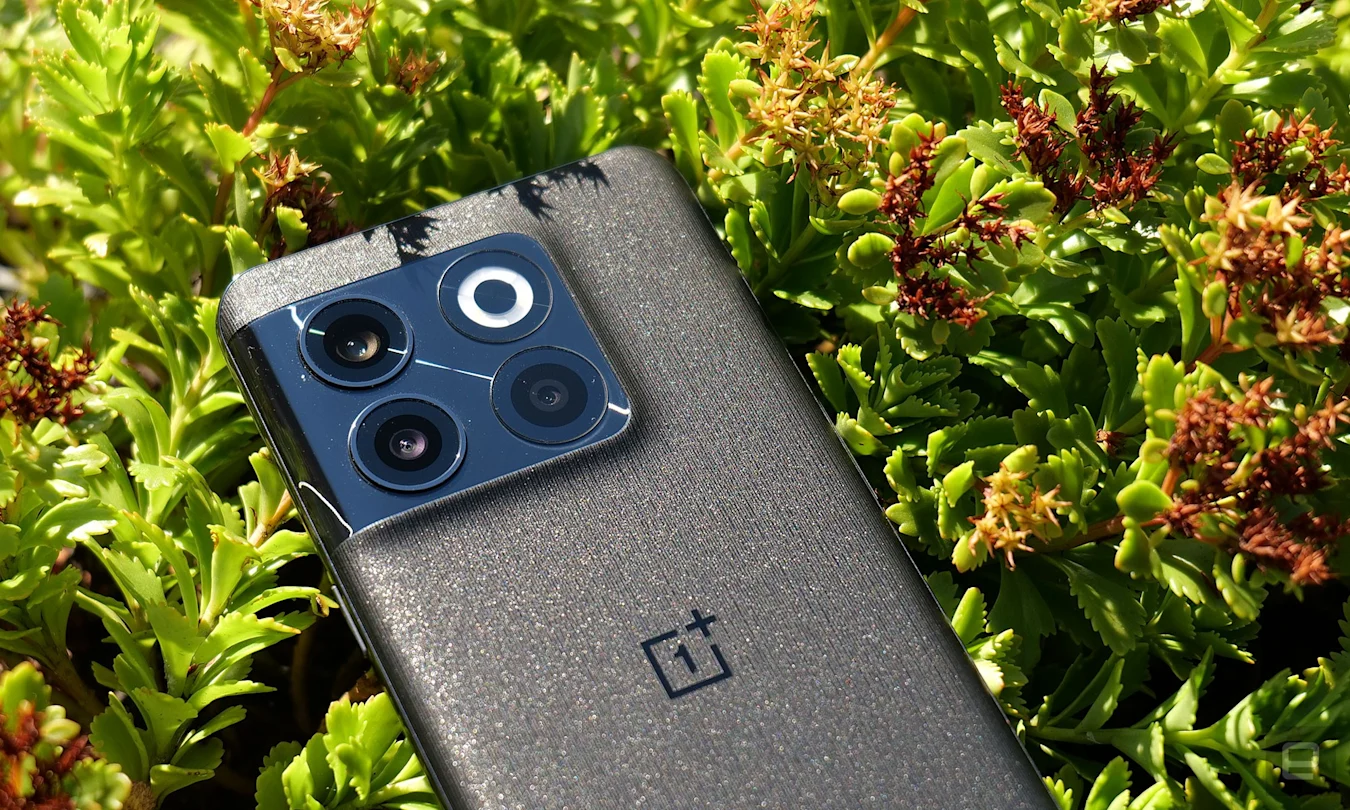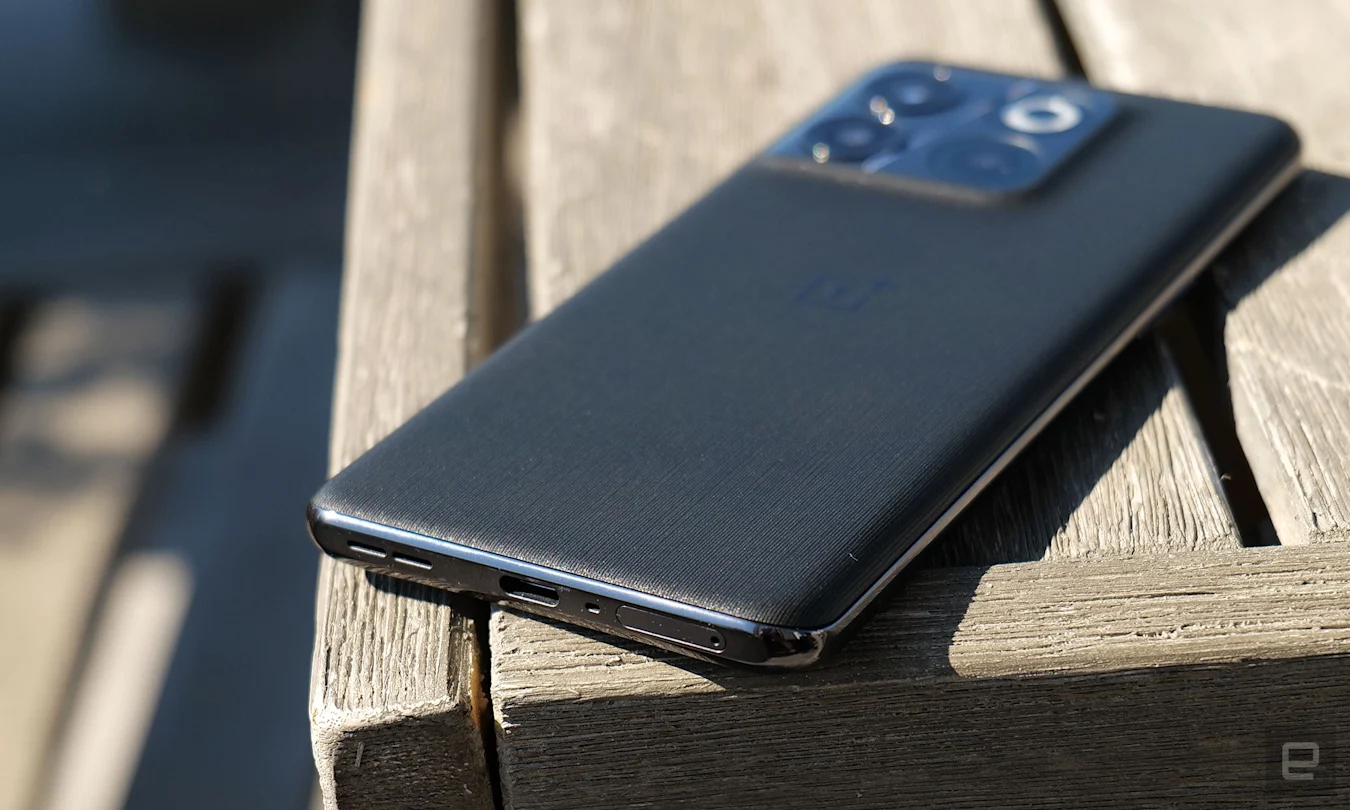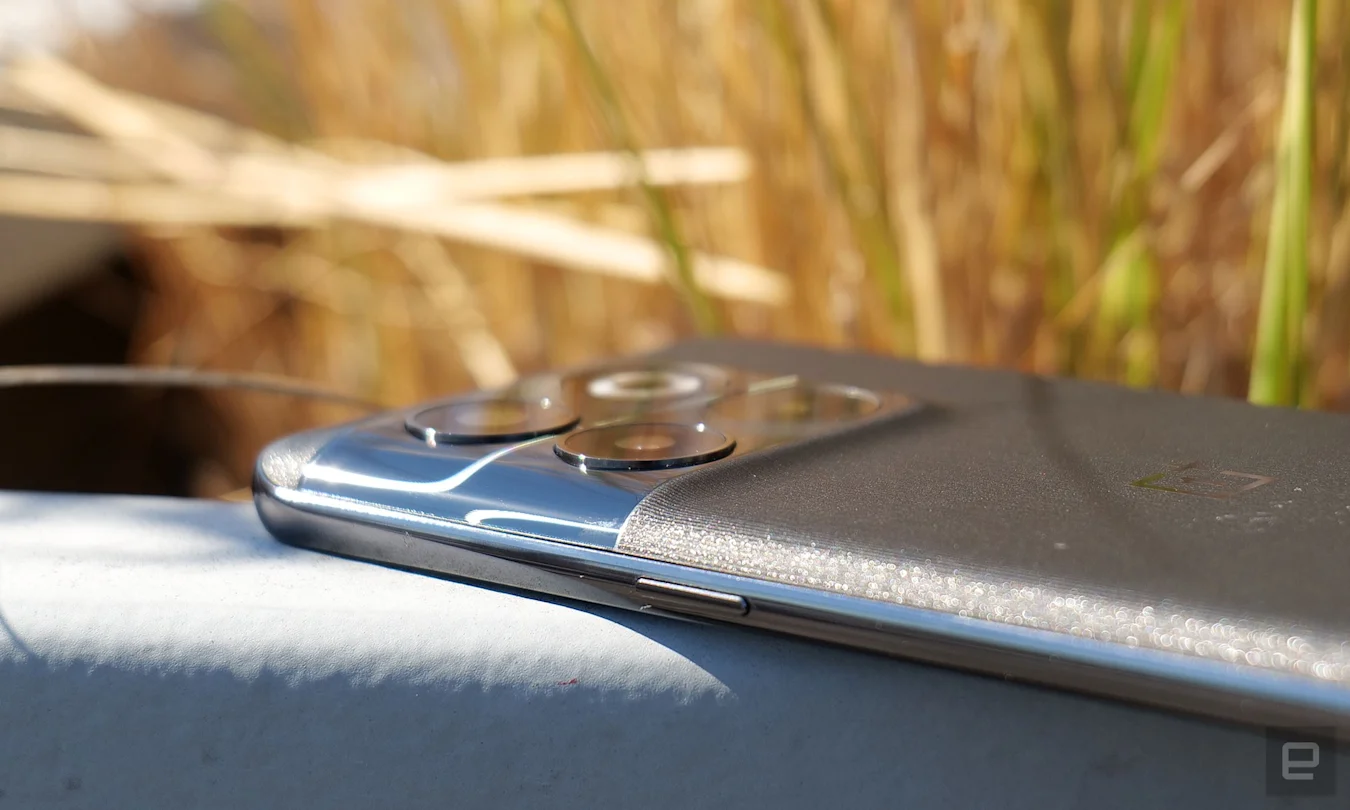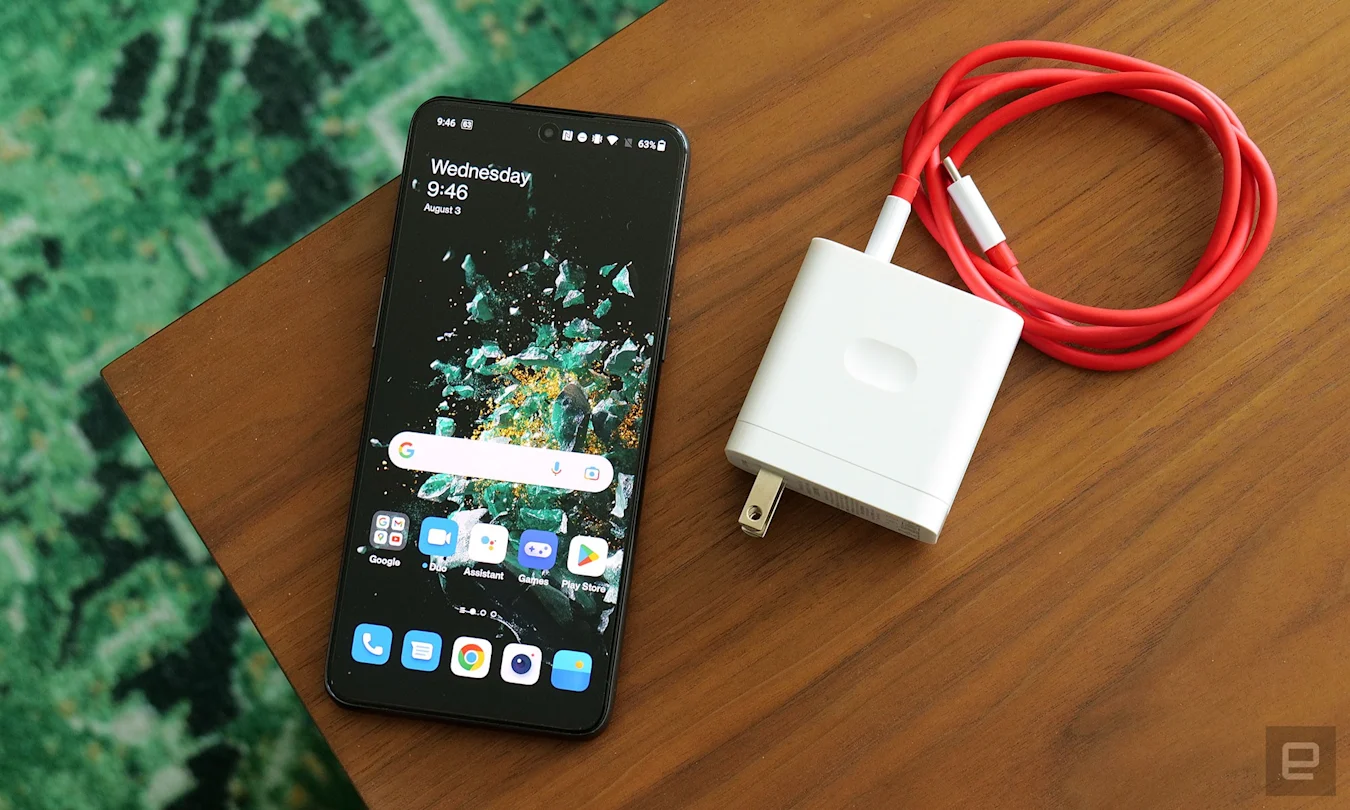When OnePlus does a mid-year refresh of its phones, typically you end up with a slightly snappier device with a handful of slight refinements. But with the new OnePlus 10T, it feels like a lot was sacrificed for the sake of going all-in on speed. Updates include a faster Snapdragon 8+ Gen 1 chip, a 120Hz display with an adaptive refresh rate, even faster charging and some tweaks for improved wireless connectivity. Unfortunately, OnePlus’ signature Alert Slider and wireless charging have been removed, and water resistance is weak. So while the 10T is a solid device with an affordable price of $649, it doesn’t have the same mass appeal as some of OnePlus’ previous offerings.
Design
For the 10T’s design, OnePlus recycled the template it created for the 10 Pro, but with some cost-saving tweaks. You get Gorilla Glass 5 in front and back, with the jade green model sporting the smooth, shiny finish you’d expect. But on our Moonstone black review unit, OnePlus used two different processes to add a textured finish the company says was inspired by basalt. This makes the phone sparkle in the sunlight, which might be nice for Twilight fans or people who aren’t planning on immediately throwing this thing in a case. That said, I think you could get a similar effect with glitter, but more than that, it makes the back of the phone feel kind of plasticky, as if it came out of a cheap 3D printer. Don’t get me wrong, this is a really minor offense, but if I was buying one, I’d go with the jade version.

Pros
- Super fast charging speeds
- Great performance
- Excellent battery life
- Adaptive 120Hz display
Cons
- No Alert Slider or wireless charging
- Weak water resistance
- Macro cam not very useful
The OP10T also features three cameras in back with a smoothed-out hump, a speedy in-screen optical fingerprint scanner and stereo speakers that are relatively loud, though there isn’t much to say about its overall audio quality. Sadly, what you won’t find is an Alert Slider, which is a feature that has been present on nearly every OnePlus phone since the OnePlus 2 way back in 2015. OnePlus claims its removal is due to space requirements for larger antennas, a bigger battery, faster charging and more, and that the slider will make a return on future devices. But all that kind of makes not having it on the 10T feel even stranger, while also removing one of the few features that gives the phone a bit of personality.
Furthermore, as a downgrade from the OnePlus 9, the 10T only gets IP-54 dust and water resistance, which is only rated to withstand a splash or two instead of a full 30-minute dunk (up to five feet) like you used to get. All around, it feels like OnePlus is regressing a bit on the design front.
Display

Sam Rutherford/Engadget
The 10T packs a big 6.7-inch 2412 x 1080 OLED display with flat edges and a 120Hz refresh rate, there’s very little to complain about here. Colors are bright and punchy while still delivering lovely inky blacks. Meanwhile, using a light meter I found that the OP10T’s screen delivers a peak brightness just shy of 800 nits, which is great. And thanks to the addition of an adaptive refresh rate that can switch from 120Hz to 90hz or 60hz depending on the content, you also get improved battery life without impacting image quality.
Performance
When it comes to speed, one of the biggest upgrades is the move to Qualcomm’s Snapdragon 8+ Gen 1 chip, which offers 30 percent better power efficiency and 10 percent faster graphics compared to the standard SD8 Gen 1. You can also configure the OP10T with up to 16GB of RAM, which OnePlus claims is enough to hold up to 35 apps open in the background, along with up to 256GB of storage.

Sam Rutherford/Engadget
All this makes the phone feel rather spritely, though there’s not much that can really tax a phone with flagship-level performance nowadays. Honestly, I can’t think of 35 or even 20 apps I’d want to keep running all the time, and in side-by-side comparisons with SD8 Gen 1 phones, it’s hard to discern much of an advantage in speed. But if you absolutely need to have the fastest silicon you can get in an Android phone, well here you go.
In addition to its new processor, the 10T also gets the same 1,000Hz touch sampling rate you get on the 10 Pro, alongside OnePlus’ HyperBoost Gaming engine which attempts to smooth out any hiccups or stutters in your framerate. And for people who care about getting the best Wi-Fi speeds, OnePlus also created its Smart Link feature, which is designed to proactively seek out strong networks. This works in tandem with the OP10T’s 360-degree antenna design, so you can get optimal signal strength regardless of how you’re holding the phone or where your connection is coming from.
Cameras

Sam Rutherford/Engadget
When it comes to photography, the 10T’s cameras are one of the biggest departures from its more expensive sibling. Not only does the 10T not have any features or tuning from Hasselblad like you get on the 10 Pro, it also lacks a dedicated telephoto lens. Instead, you get a 50MP main camera based on a Sony IMX766 sensor, an 8MP ultra-wide cam and a 2MP macro cam.
Thankfully, even without help from Hasselblad, the 10T’s image quality is still pretty good. During the day, you get rich saturated colors and relatively sharp details. It was only after I compared the 10T’s pics with similar shots from the $500 Pixel 6a that I noticed it sometimes oversharpens things a touch or exaggerates more vivid colors like the oranges on a flower. At night, the 10T holds up pretty well too, though I still have to give the Pixel 6a an advantage in low light thanks to Google’s Night Sight mode. In general, the 10T captured sharp, well-lit images that were a touch behind what I shot using the Pixel 6a.
Gallery: OnePlus 10T photo comparisons | 10 Photos
Gallery: OnePlus 10T photo comparisons | 10 Photos
As for the other cams, the ultra-wide is totally serviceable and provides a more expansive 120-degree field of view compared to the 50MP main lens. Unfortunately, the macro cam is kind of a bust, because while it can take photos from just an inch and a half away (4cm), its low resolution and hit-or-miss focus means you’re often better off just using the main cam and cropping.
Battery life and charging
Ok, let’s talk charging because while the 80-watt charging on the 10 Pro was anything but slow, the new 150-watt Super VOOC system on the 10T is ridiculously fast and actually lives up to OnePlus’ lofty claims. Starting with just a one percent charge, the OP10T added just shy of 60 percent battery in just 10 minutes, before going on to hit 86 percent in 20 minutes and 100 percent in less than half an hour. That’s more than twice as fast as what you get from a lot of other high-end Android phones, including stuff like the $1,200 S22 Ultra and its slower 45-watt fast charging.

Sam Rutherford/Engadget
That said, there are a number of caveats about the 10T’s 150-watt Super VOOC charging you should know. The first is that you can only get these speeds when using OnePlus’ included power adapter and cable. (But hey, at least you get a charging brick in the box unlike a lot of other phones.) When I tried charging the phone with two other 130-watt or higher third-party adapters, the 10T added less than 20 percent battery in 10 minutes, and that was even when using OnePlus’ cable.
Additionally, because OnePlus’ power brick doesn’t support the 110 or 120-volt outlets that are most common in the US, charging actually caps out at 125 watts. However, if you’re in Europe or India, you will get that full 150 watts. Finally, for anyone dreaming of juicing up a laptop or some other gadget with OnePlus’ big brick, you should know that standard USB-PD charging is capped at 45 watts. And despite having a label on the brick that says 160 watts, regardless of where you are, charging speeds cap out at 150 watts.

Sam Rutherford/Engadget
As for battery life itself, the 10T is downright fantastic. Even though it has a slightly smaller capacity than the OP10 Pro (4,800 mAh vs. 5,000 mAh), it lasted almost 22 hours on our video rundown test (21 hours and 59 minutes to be exact). That’s the best time we’ve seen this year, even beating out the Pixel 6a’s mark of 19:30.
And for those worried about what the 10T’s rapid charging might do to its battery health, OnePlus says the phone has 13 temperature sensors to make sure it doesn’t overheat while charging, while its duel-cell power pack helps spread electrons more evenly and efficiently. This is meant to help the 10T retain 80% battery health after 1,600 charging cycles, though obviously, we haven’t had time to test that out fully.
Software
When it comes to software, nowadays most Android phone makers have gotten their custom skins in a pretty decent spot. However, with OnePlus’s OxygenOS having transitioned to a platform based on Oppo’s ColorOS starting with the 10 Pro and now the 10T, things can feel a bit jarring for long-time OnePlus fans. That’s because while you still get things like the OnePlus Sans font, other elements like the settings menu, UI, and even some of OxygenOS 12’s new sounds constantly remind you that this isn’t the operating system you’re used to.

Sam Rutherford/Engadget
There’s a new Shelf that’s sort of like a blend between the Control Center on iPhones and a dedicated place for widgets that feels somewhat redundant. I’ve also noticed some odd bugs and inconsistencies like not getting a pop-up to enable file transfers when connecting the phone to a PC over USB-C. To fix this I had to manually enable Android’s developer settings, which isn’t something that an average user should need or have to do.
On the bright side, the 10T should enjoy solid software support, with OnePlus promising at least three major Android updates and four years of regular security patches. The company even says it plans to upgrade some of its phones to Android 13 later this fall, starting with the OnePlus 10 Pro, not the 10T, and moving on from there.
Availability
The OP10T will be available in Europe on August 25th starting at €699 for the 8GB/128GB config, or on September 29th in the US starting at $649. For US customers, there will also be a handful of pre-sale dates on OnePlus.com on August 3rd-6th, 10th-13th, 17th-20th and 24th-27th. OnePlus says anyone who buys a phone during early access will also be eligible for a free upgrade to the 16GB/256GB config along with zero interest if you opt for the company’s 24-month payment plan.
Wrap-up
So, the big question is should you get one? For the kind of people who crave speed, the OnePlus 10T is an interesting device. It has top-of-the-line performance, a big OLED screen and stupidly fast charging for just $650 for 8GB of RAM and 128GB of storage, or $750 for the 16GB + 256GB config. Its camera quality is solid too, even though I wish OnePlus had opted for a zoom lens instead of a macro. And its battery life is truly superb.

Sam Rutherford/Engadget
The somewhat disappointing part are some of the cuts made to achieve all this speed. You don’t get OnePlus’ signature Alert Slider, there’s no support for wireless charging, and its water resistance is mediocre. Another annoying wrinkle is that OnePlus has yet to detail carrier compatibility for the US (the company says more info will be available closer to launch, stay tuned for updates) .So while it’s super fast, the OP10T isn’t as well-rounded as phones like the Pixel 6. To complicate things even more, alongside the 10T’s release, OnePlus is permanently reducing OP 10 Pro’s starting price from $899 to $799. That puts the 10T in a tough spot between great values like the $500 Pixel 6a or the $600 Pixel 6 and more full-featured phones like the S22 and OP10 Pro. But if you gotta go fast and want an affordable phone with excess haste, the 10T might be exactly what you need.
All products recommended by Engadget are selected by our editorial team, independent of our parent company. Some of our stories include affiliate links. If you buy something through one of these links, we may earn an affiliate commission.
Credit: Source link


Comments are closed.